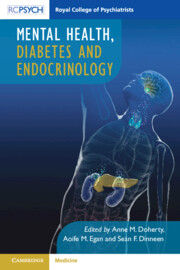Book contents
- Mental Health, Diabetes and Endocrinology
- Mental Health, Diabetes and Endocrinology
- Copyright page
- Contents
- Contributors
- Preface
- Chapter 1 An Introduction to Psychiatry in Endocrinology
- Chapter 2 Depression across Endocrine Disorders
- Chapter 3 Antipsychotic Medications and Metabolic Syndrome
- Chapter 4 ‘Diabulimia’, Diabetes and Eating Disorders
- Chapter 5 Disorders of the Hypothalamic–Pituitary–Adrenal Axis
- Chapter 6 Disorders of the Thyroid and Parathyroid
- Chapter 7 Psychological Factors Impacting on Endocrine Disorders and Self-Management and Medication-Taking Behaviour
- Chapter 8 Cognitive Impairment and Endocrine Conditions
- Chapter 9 Suicidal Ideation and Self-Harm
- Chapter 10 Obesity and Mental Health
- Chapter 11 Gender Incongruence
- Chapter 12 Anti-androgens in Forensic Psychiatric Settings
- Chapter 13 Service- and Setting-Related Challenges
- Index
- References
Chapter 12 - Anti-androgens in Forensic Psychiatric Settings
Published online by Cambridge University Press: 14 October 2021
- Mental Health, Diabetes and Endocrinology
- Mental Health, Diabetes and Endocrinology
- Copyright page
- Contents
- Contributors
- Preface
- Chapter 1 An Introduction to Psychiatry in Endocrinology
- Chapter 2 Depression across Endocrine Disorders
- Chapter 3 Antipsychotic Medications and Metabolic Syndrome
- Chapter 4 ‘Diabulimia’, Diabetes and Eating Disorders
- Chapter 5 Disorders of the Hypothalamic–Pituitary–Adrenal Axis
- Chapter 6 Disorders of the Thyroid and Parathyroid
- Chapter 7 Psychological Factors Impacting on Endocrine Disorders and Self-Management and Medication-Taking Behaviour
- Chapter 8 Cognitive Impairment and Endocrine Conditions
- Chapter 9 Suicidal Ideation and Self-Harm
- Chapter 10 Obesity and Mental Health
- Chapter 11 Gender Incongruence
- Chapter 12 Anti-androgens in Forensic Psychiatric Settings
- Chapter 13 Service- and Setting-Related Challenges
- Index
- References
Summary
The assessment and treatment of paraphilias and sex offenders are highly complex. The limited evidence base for treatment extends to both psychological and talking therapy interventions, as well as biological and medication-based interventions. Biological interventions and medical management of sexual offending are particularly challenging areas. Evidence is at the emerging stage only in this area, and Cochrane reviews have advised that further research is required. Nonetheless, given the serious outcomes of potential risks to the patient, such as prolonged stays in secure settings, and to the public in the event of recidivism, medication can be considered in the highest-risk groups. Such treatment regimens require careful assessment, consideration and ongoing management. Consent and motivation for treatment in the individual patient are key to the success or failure of an intervention with such anti-libidinal medications, as the patient will need to voluntarily comply with this treatment in the community in the medium or long term. Patients who find their intrusive sexual thoughts ego-dystonic are probably the most suitable candidates for consideration for such treatment. It is therefore appropriate that such treatments are offered to the highest-risk offenders only.
- Type
- Chapter
- Information
- Mental Health, Diabetes and Endocrinology , pp. 127 - 136Publisher: Cambridge University PressPrint publication year: 2021



